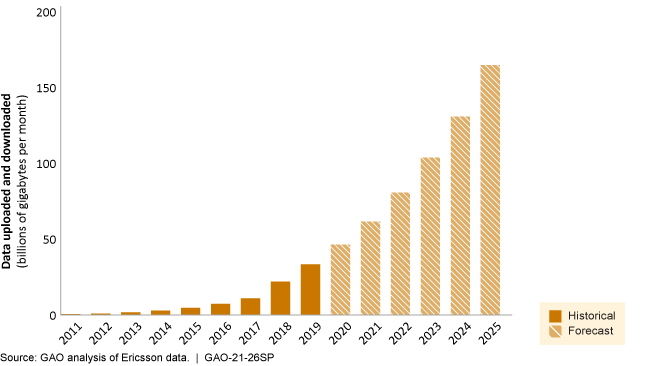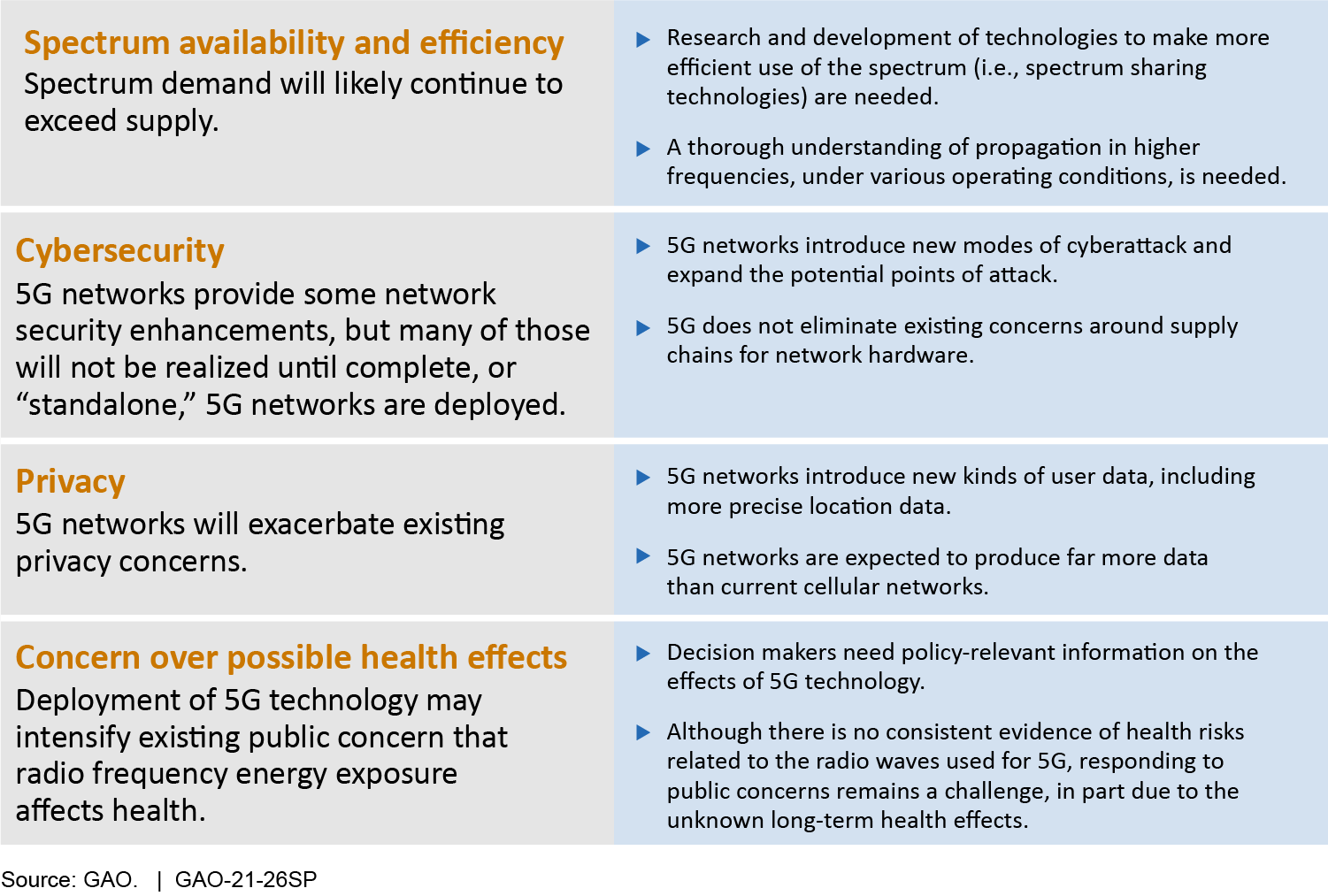5G Wireless: Capabilities and Challenges for an Evolving Network
Fast Facts
Fifth-generation (5G) wireless promises not just to increase speeds but to enable new applications like automated cars and smart factories.
We reviewed U.S. 5G development. It's still early, with efforts focusing on increasing speed and connecting more devices. Technologies that enable 5G's full potential are expected within the next decade.
We also highlight key challenges to 5G and present policy options to address them. For example, 5G is expected to greatly increase data transmission, which would require more radio frequency spectrum—a scarce resource. To help, policymakers could promote research into more efficient use of radio spectrum.
Forecast of total worldwide mobile data usage

Highlights
What GAO Found
Fifth-generation (5G) wireless networks promise to provide significantly greater speeds and higher capacity to accommodate more devices. In addition, 5G networks are expected to be more flexible, reliable, and secure than existing cellular networks. The figure compares 4G and 5G performance goals along three of several performance measures.

Note: Megabits per second (Mbps) is a measure of the rate at which data is transmitted, milliseconds (ms) is a measure of time equal to one thousandth of a second, and square kilometer (km²) is a measure of area.
As with previous generations of mobile wireless technology, the full performance of 5G will be achieved gradually as networks evolve over the next decade. Deployment of 5G network technologies in the U.S. began in late 2018, and these initial 5G networks focus on enhancing mobile broadband. These deployments are dependent on the existing 4G core network and, in many areas, produced only modest performance improvements. To reach the full potential of 5G, new technologies will need to be developed. International bodies that have been involved in defining 5G network specifications will need to develop additional 5G specifications and companies will need to develop, test, and deploy these technologies. GAO identified the following challenges that can hinder the performance or usage of 5G technologies in the U.S.

GAO developed six policy options in response to these challenges, including the status quo. They are presented with associated opportunities and considerations in the following table. The policy options are directed toward the challenges detailed in this report: spectrum sharing, cybersecurity, privacy, and concern over possible health effects of 5G technology.
Policy options to address challenges to the performance or usage of U.S. 5G wireless networks
| Policy Option | Opportunities | Considerations |
|
Spectrum-sharing technologies (report p. 47)
|
|
|
|
Coordinated cybersecurity monitoring (report p. 48)
|
|
|
|
Cybersecurity requirements (report p. 49)
|
|
|
|
Privacy practices (report p. 50)
|
|
|
|
High-band research (report p. 51)
|
|
|
| Status quo (report p. 52) |
|
|
Why GAO Did This Study
GAO was asked to assess the technologies associated with 5G and their implications. This report discusses (1) how the performance goals and expected uses are to be realized in U.S. 5G wireless networks, (2) the challenges that could affect the performance or usage of 5G wireless networks in the U.S., and (3) policy options to address these challenges.
To address these objectives, GAO interviewed government officials, industry representatives, and researchers about the performance and usage of 5G wireless networks. This included officials from seven federal agencies; the four largest U.S. wireless carriers; an industry trade organization; two standards bodies; two policy organizations; nine other companies; four university research programs; the World Health Organization; the National Council on Radiation Protection and Measurements; and the chairman of the Defense Science Board's 5G task force. GAO reviewed technical studies, industry white papers, and policy papers identified through a literature review. GAO discussed the challenges to the performance or usage of 5G in the U.S. during its interviews and convened a one-and-a-half day meeting of 17 experts from academia, industry, and consumer groups with assistance from the National Academies of Sciences, Engineering, and Medicine.
GAO received technical comments on a draft of this report from six federal agencies and nine participants at its expert meeting, which it incorporated as appropriate.
For more information, contact Hai Tran at (202) 512-6888, tranh@gao.gov or Vijay A. D’Souza at (202) 512-6240, dsouzav@gao.gov.
